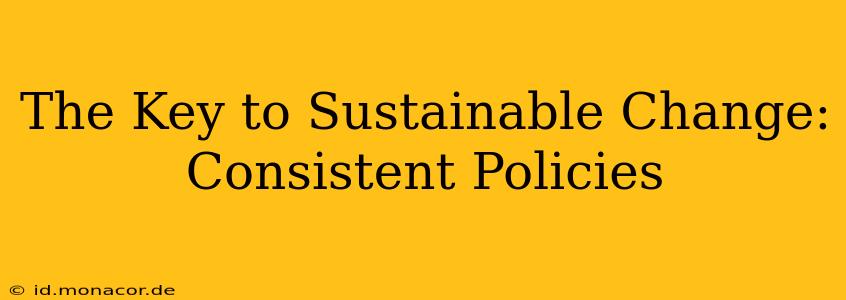Sustainable change, whether in personal life, business, or global initiatives, isn't about fleeting trends or quick fixes. It's a marathon, not a sprint, and the key to success lies in the consistent application of well-defined policies. This means establishing clear goals, developing robust strategies, and steadfastly adhering to them over time, even when faced with challenges or setbacks. This article will delve into why consistent policies are crucial for achieving lasting positive change and explore strategies for implementing them effectively.
What Makes a Policy "Consistent"?
Consistency in policy doesn't imply rigidity. It refers to the unwavering commitment to the core principles and objectives of a policy, even as the methods of implementation might evolve or adapt to changing circumstances. A consistent policy remains true to its overarching goals, adapting its approach strategically rather than abandoning its fundamental principles. This adaptability is key; a rigid, inflexible policy can become obsolete and ineffective in a dynamic environment.
Why are Consistent Policies Crucial for Sustainable Change?
Consistent policies foster several crucial elements for sustainable change:
-
Predictability and Trust: Consistent policies create a predictable environment. This predictability is vital for stakeholders, whether they're employees, citizens, or investors. It builds trust, enabling collaboration and buy-in, which are essential for long-term success.
-
Accountability and Transparency: Consistent policies provide a framework for accountability. When clear rules and expectations are in place, it's easier to measure progress, identify areas needing improvement, and hold individuals or organizations accountable for their actions. Transparency in policy implementation further enhances accountability.
-
Long-Term Vision: Sustainable change requires a long-term perspective. Consistent policies provide the foundation for pursuing long-term goals without being derailed by short-term fluctuations or pressures. They allow for sustained effort and investment towards achieving ambitious targets.
-
Resource Optimization: Consistent policies optimize the allocation and utilization of resources. By sticking to a defined plan, resources aren't wasted on inconsistent or conflicting initiatives. This efficient resource management is critical for achieving sustainable outcomes.
-
Improved Outcomes: Ultimately, consistent policies lead to improved outcomes. By reducing uncertainty and maximizing efficiency, they increase the likelihood of achieving the desired goals, whether it's reducing carbon emissions, improving public health, or enhancing productivity in the workplace.
How to Implement Consistent Policies Effectively?
Implementing consistent policies requires careful planning and execution. Here are some key steps:
-
Clear Goal Setting: Define clear, measurable, achievable, relevant, and time-bound (SMART) goals. These goals will serve as the guiding principles for all policy-related decisions.
-
Stakeholder Engagement: Involve stakeholders in the policy development process. This ensures that the policies are relevant, acceptable, and have broader support.
-
Robust Monitoring and Evaluation: Implement a robust monitoring and evaluation system to track progress, identify challenges, and make necessary adjustments. Regular review and adaptation are crucial for maintaining policy effectiveness.
-
Open Communication: Maintain open and transparent communication throughout the process. Regular updates and feedback mechanisms help to keep stakeholders informed and engaged.
-
Flexibility and Adaptation: While consistency is key, policies should be flexible enough to adapt to changing circumstances. This adaptability prevents the policy from becoming irrelevant and ensures continued effectiveness.
What are the consequences of inconsistent policies?
Inconsistent policies lead to several negative consequences:
-
Erosion of Trust: Frequent policy changes or a lack of adherence to existing policies erode trust among stakeholders, leading to decreased participation and collaboration.
-
Wasted Resources: Inconsistent policies lead to inefficient resource allocation, resulting in wasted time, money, and effort.
-
Missed Opportunities: A lack of consistent direction and focus prevents the realization of opportunities for significant, sustainable progress.
-
Negative Outcomes: Ultimately, inconsistent policies are less likely to achieve their desired outcomes, leading to frustration and potentially causing damage.
Conclusion: The Power of Persistence
Sustainable change is a journey, not a destination. Consistent policies are the compass and roadmap that guide us toward our goals. By embracing a long-term perspective, fostering collaboration, and adapting strategically, we can harness the power of consistent policies to create lasting, positive change in the world. The key is not just having a good policy but ensuring its unwavering implementation and strategic adjustment over time.

